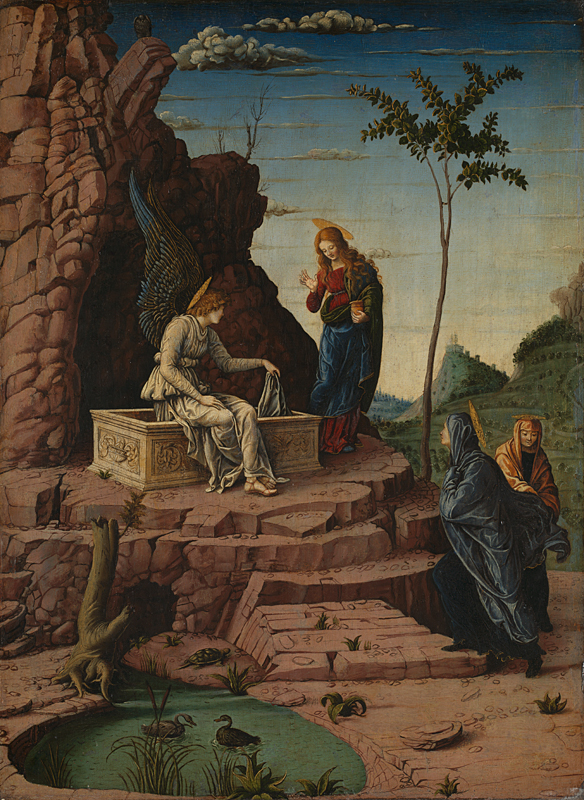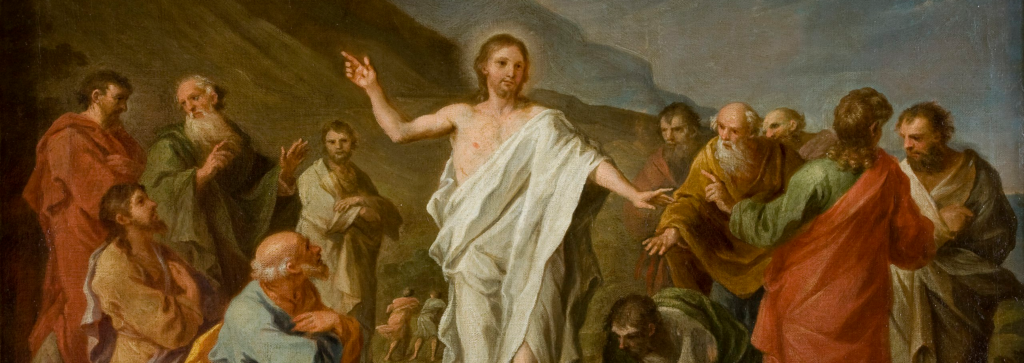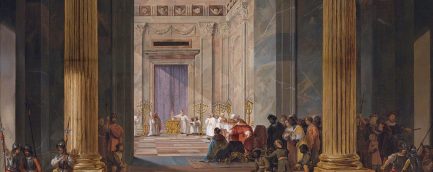Present
Beyond Time

To listen to the story, click on the player.
For better enjoyment, use earphones.
I
It is Pesach, the Jewish Passover in Jerusalem. In the seventeenth year of Emperor Tiberius Caesar, on the twenty-seventh day of March. We can see that today is unlike any other Pesach, for what is about to happen will forever change the course of history.
It’s Friday morning, the air seems charged with a tangible tension, as if the city itself were holding its breath. There is a strange energy in the air, a mixture of expectation, fear, and disbelief. For Jesus’ disciples, the morning brings more than a foreboding sense; it is almost a terrible certainty that something irreversible is about to happen. Above all, there is the feeling that this Friday will not be like any other.
Jesus was arrested at dawn and handed over to the Sanhedrin for questioning, then taken to Pilate, and finally led by the Roman guard to a place called Golgotha. It was nine o’clock in the morning.
Visible to whoever passes by, Golgotha is an open and elevated area outside the walls of Jerusalem, where those sentenced to death are exposed, and the people can watch in terror as the Roman soldiers carry out their orders. All the characters in this story are there: some indifferent executors, others with hearts shattered by pain.
And suddenly, darkness fell over the entire city at noon, the earth trembled, rocks split, and night came while it was still day.
The rustling of the wind is overcome by a greater sound, and at three o’clock in the afternoon, Jesus cries out:
“Eli, Eli, Lamah shavahhtani!”
“(God, God, how You glorify me!)”
(*1)
Peter, one of the disciples who was watching what was happening at Golgotha from afar, is astonished to see the image of the Lord near him, higher up among the trees, and says:
“What do I see, O Lord? That it is truly You whom they are leading away, and that You are holding me? Or who is this, joyful and laughing in the tree? And is it another whose hands and feet they are nailing?”
Jesus answers:
“The one you saw in the tree, joyful and laughing, is the living Jesus. But the one whose hands and feet they are nailing is His fleshly part, the shamed substitute, the one who came to be in His likeness. But look at him and at Me.”
But Peter, upon looking, says:
“Lord, no one is looking at You. Let us run away from this place.”
The Master declares:
“I have already told you: ‘Leave the blind alone!’”
(*2)
II
A certain man, named Joseph, a counselor from the city of Arimathea, went to Pilate and asked for the body of Jesus. Joseph of Arimathea was a respected man among the Jews, a member of the Sanhedrin who, although discreet, believed that Jesus was a righteous man. Upon seeing his Master crucified, he felt in his heart the need to give Him a dignified burial.
With courage, he approached the Roman governor of Judea and requested permission to take the body. Permission was granted, and he took it to a new tomb, belonging to his family—a place reserved for his own. There, following the customs of the time, they wrapped the body in linen cloths and aromatic spices, as was the Jewish tradition. Joseph of Arimathea wrapped Him in a clean shroud and laid Him in a rock-hewn tomb, where no one had ever been placed before. He was accompanied by Nicodemus.
(*3)
With reverence and sorrow, they sealed the tomb’s entrance with a large stone. They seemed hurried, for Shabbat was about to begin, and no work could be done on that sacred day. Silently, Joseph of Arimathea and Nicodemus departed.
III
On Sunday morning, after Shabbat, some women walk through the still-empty streets toward a garden near Golgotha. They wish to complete the burial rites that Joseph of Arimathea and Nicodemus had started but had to interrupt due to the Sabbath. They carry perfumes and aromatic spices.
One of them walks slightly ahead; it is Mary Magdalene. In deep sadness, her heart is heavy. At the foot of the cross, she had witnessed Jesus’ last breath, and she asks herself:
“Who will roll the stone away for us?”
The tomb had been sealed with a massive stone, and without help, they could not enter.
As they arrive, the question becomes irrelevant as the stone had already been rolled away. Another question immediately arises: Who would have done it? Perhaps a great tremor? Another tremor? Matthew, in his account, would later confirm it.
Intrigued, they run into the tomb. It is empty.

On Sunday morning, after Shabbat, some women walk through the still-empty streets toward a garden near Golgotha. They wish to complete the burial rites that Joseph of Arimathea and Nicodemus had started but had to interrupt due to the Sabbath. They carry perfumes and aromatic spices.

One of them walks slightly ahead; it is Mary Magdalene. In deep sadness, her heart is heavy. At the foot of the cross, she had witnessed Jesus’ last breath, and she asks herself:
“Who will roll the stone away for us?”
The tomb had been sealed with a massive stone, and without help, they could not enter.
As they arrive, the question becomes irrelevant as the stone had already been rolled away. Another question immediately arises: Who would have done it? Perhaps a great tremor? Another tremor? Matthew, in his account, would later confirm it.
Intrigued, they run into the tomb. It is empty.
“Where is the body of the Lord Jesus?” they wonder.
Imagine how shocked they must have been, not knowing what to do. At that moment, two men in radiant clothes shining like the Sun appear beside them.
Who could they be? Angels?
One of them asks:
“Are you looking for Jesus of Nazareth, who was crucified? He is not here. He has risen as He said He would. Go and tell His disciples what you have seen.”
The women ran out frightened, but filled with joy.
Mary Magdalene runs ahead when, suddenly, she encounters a man she assumes to be the gardener:
“Woman, why are you crying? Whom do you seek?”
Still not recognizing Him, Mary pleads:
“Sir, if You have taken Him, tell me where You have laid Him, and I will take Him away.”
Then, He says only one word:
“Mary.”
His voice was familiar, gentle, full of love and authority. Her heart seemed to stop for a moment.
“Master!” she exclaimed, falling to her knees and reaching out to touch Him.
Jesus greets them and says:
“Rejoice! Do not be afraid; go and tell My brothers to go to Galilee; there they will see Me.”
(*4)
Upon meeting the disciples again, her face radiated a different light.
“I have seen the Lord!” she announced, her voice full of emotion, and told them everything that had happened – every word, every detail. Gradually, the disbelief in the disciples’ eyes gave way to faith, to renewed hope.
After receiving Mary Magdalene’s news, Peter and John ran to the tomb. It is possible to imagine them entering the tomb and not finding the Master’s body. Jesus had foretold His resurrection, but they had not believed. And now, would this be enough for them to believe?
IV
Days go by, and John is still filled with doubt, but his seeking soul does not waver. He walks around the streets of Jerusalem, and many question him about where his Master is. His heart is restless, struggling to understand what has happened.
Then, Jesus appears to John:
“John, why do you fear and doubt when I come to you? This appearance should not be strange to you. Do not be afraid, for it is I, the One who is always with you… Behold, I have come to reveal to you what is, what was, and what will be, so that you may recognize both the visible and the invisible, and to teach you about the Perfect Man…”
(*5)

V
And to Galilee, the origin of everything, the disciples return in response to a call:
“Go back to where it all began, to the beginning of the gospel.”
Jesus, fulfilling yet another of His promises, first appears to His closest disciples. At the shore of the great lake, He guides them in fishing until their nets are filled with fish once again. He prepares them a meal of bread and fish, and after they eat, He asks Peter three times:
“Simon, son of John, do you love Me?”
Peter answers affirmatively each time, and then Jesus tells him:
“Feed My sheep… Follow Me.”
(*6)
Jesus also appears to more than five hundred people and teaches once again:
“Go and make disciples in all nations… I will always be with you.”
(*7)
Together, all these accounts of His appearances make it clear that Jesus is not among the dead, but among the living. He manifests Himself in a completely new way, no longer confined to time and space, but as a figure of the present.
Others, throughout this period, bore witness of His appearances, but this experience is not essential, for He Himself says to Thomas:
“Blessed are those who have not seen and yet have believed.”
(*8)
Jesus teaches a New Commandment:
“Just as the Father has loved Me, so I have loved you. Remain in My love… This is My commandment: that you love one another as I have loved you.”
(*9)
And He leaves a new meaning for Passover:
Eternal Life.
References
(*1) – More recent editions of the New Testament replace “Eli, Eli, Lamah sabachtani.”, which was translated as “Eli, Eli, why have You forsaken Me?”, with the verb shavahh, which means to bring peace, glorify, and console, thus completely changing the meaning.
(*2) – Apocalypse of Peter – Selection from James M. Robinson, ed., The Nag Hammadi Library, revised edition. HarperCollins, San Francisco, 1990.
(*3) – Gospel of Nicodemus = Acts of Pilate
(*4) – Matthew 28:10
(*5) – The Apocryphal Gospel of John
(*6) – John 21
(*7) – Matthew 28:16-20 and 1 Corinthians 15:6-7
(*8) – John 20:29
(*9) – John 15:9-17


